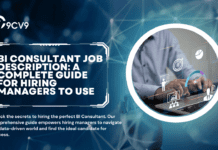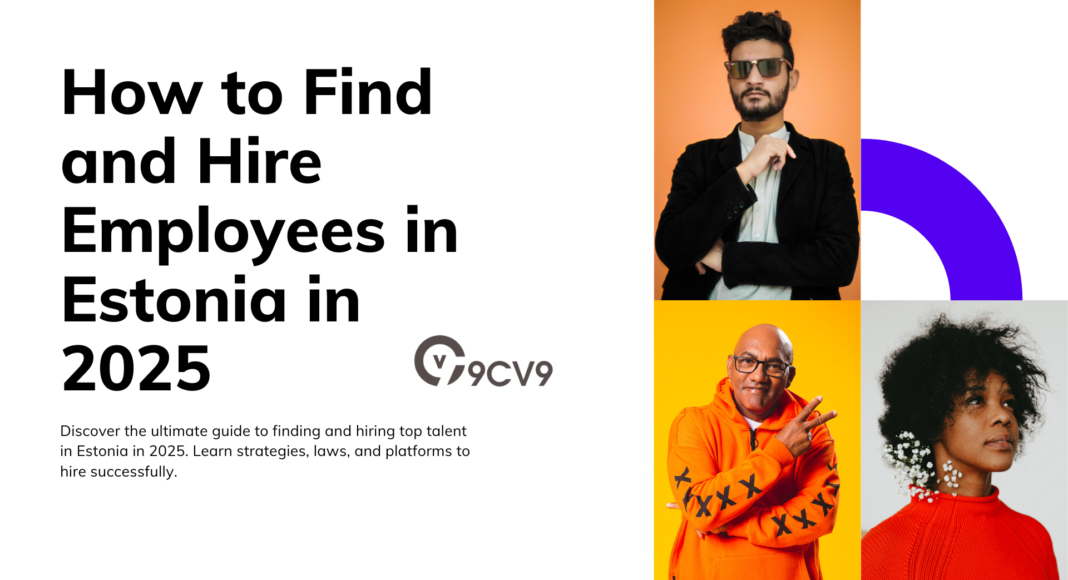Key Takeaways
- Leverage digital platforms like 9cv9 Job Portal to efficiently connect with Estonia’s skilled, multilingual workforce.
- Stay competitive by offering flexible work arrangements and embracing remote work trends to attract top talent.
- Ensure legal compliance with Estonian labor laws and invest in employer branding to retain employees and support global expansion.
As one of the most digitally advanced and business-friendly countries in the European Union, Estonia has rapidly become a top destination for companies looking to expand and tap into a highly skilled workforce.
In 2025, Estonia’s dynamic labor market offers a wealth of opportunities for businesses seeking qualified employees across various sectors.
Whether you’re a startup looking to scale, an established company expanding your operations, or an international business exploring new talent pools, Estonia presents an ideal landscape for recruitment and growth.

In recent years, Estonia has earned a reputation for its innovative approach to business, with cutting-edge technology, a streamlined digital ecosystem, and a forward-thinking government that encourages entrepreneurship.
Estonia’s renowned e-Residency program has attracted digital entrepreneurs and remote workers from around the world, further solidifying the country’s status as a global hub for talent. As a result, Estonia not only offers access to a rich talent pool but also provides an environment where businesses can thrive in a digital-first landscape.
However, as the demand for top-tier talent continues to rise, understanding how to effectively find and hire employees in Estonia has become essential for businesses aiming to stay competitive in a rapidly evolving market. From understanding local recruitment laws to leveraging Estonia’s digital platforms and talent resources, the hiring process requires careful planning and execution.
In this comprehensive guide, we will explore the most effective strategies for hiring employees in Estonia in 2025.
We will cover critical aspects such as understanding the local labor market, navigating legal and regulatory requirements, leveraging Estonia’s digital platforms, and attracting top talent from both local and international sources.
Additionally, we’ll look at how businesses can create an attractive work environment, onboard new employees seamlessly, and retain top talent in a competitive job market.
Whether you’re planning to hire locally in Estonia or tap into its remote workforce, this guide will provide you with all the information you need to successfully recruit and build a strong team in one of Europe’s most forward-looking countries.
From small businesses to multinational corporations, this step-by-step approach will help you understand the nuances of the Estonian hiring process and give you the tools to secure the best talent for your company in 2025.
How to Find and Hire Employees in Estonia in 2025
- Understanding the Estonian Job Market in 2025
- Navigating Estonian Recruitment Laws and Regulations
- Top Platforms and Methods for Job Search in Estonia
- Attracting Top Talent to Your Company
- The Role of Remote Work and Digital Nomads in Hiring
- Screening and Interviewing Candidates in Estonia
- Onboarding and Retaining Employees in Estonia
- Leveraging Estonia’s Talent Pool for Global Expansion
1. Understanding the Estonian Job Market in 2025
As of 2025, Estonia’s job market continues to evolve in response to both global and local economic shifts, technological advancements, and demographic changes. Estonia’s reputation for innovation, its digitally-driven economy, and its status as one of Europe’s most progressive countries in terms of business-friendly policies make it an attractive destination for both employers and employees. Understanding the key trends, opportunities, and challenges in the Estonian job market is critical for businesses looking to hire in the country.
Key Trends Shaping the Estonian Job Market in 2025
- Digital Transformation:
- Estonia remains a global leader in digital transformation, driven by initiatives like the e-Residency program and the integration of technology into government services.
- Tech and IT-related roles are in high demand, including software developers, data analysts, cybersecurity experts, and AI specialists.
- Estonia’s focus on digitizing industries and implementing Industry 4.0 technologies means that digital skills are now required across almost all sectors, not just in tech.
- Remote Work and Hybrid Employment Models:
- Estonia’s digital infrastructure supports a highly flexible work culture, making remote work increasingly popular, especially post-pandemic.
- Many businesses, particularly in tech, have adopted hybrid work models, allowing employees to work from anywhere.
- The country’s e-Residency program attracts international talent, contributing to the growing demand for remote work opportunities in Estonia.
- Growing Demand for Green and Sustainability Jobs:
- Estonia’s commitment to environmental sustainability is shaping the job market. The government has outlined ambitious goals for reducing carbon emissions and investing in renewable energy.
- This has resulted in a rising demand for specialists in renewable energy, sustainable construction, green technology, and environmental consulting.
- Rise of Startups and Innovation:
- Estonia’s startup ecosystem is thriving, with Tallinn being one of Europe’s leading startup hubs. The country is home to numerous successful startups like TransferWise (now Wise) and Bolt.
- Startups in Estonia are increasingly looking for employees with entrepreneurial mindsets and skills that align with the fast-paced nature of startup environments, such as adaptability, problem-solving, and innovation.
Overview of In-Demand Sectors and Skill Sets
- Technology and IT:
- The tech sector remains the largest and most rapidly growing in Estonia. From software development and data analytics to AI and blockchain, the demand for tech talent is expected to continue growing in 2025.
- Common in-demand roles:
- Software Engineers: Focused on developing cutting-edge applications and systems.
- Data Scientists: Skilled in interpreting complex datasets and providing business insights.
- Cybersecurity Experts: Vital for protecting digital infrastructure, especially with Estonia’s emphasis on e-government services.
- Blockchain Developers: Estonia has been a pioneer in blockchain technology, particularly in public sector applications, driving demand for blockchain experts.
- Finance and Business Services:
- Estonia’s growing financial technology (fintech) sector and its strategic location in Northern Europe continue to attract businesses in banking, investment, and insurance services.
- Financial Analysts, Risk Managers, and Compliance Officers are particularly sought after, as Estonia plays a key role in Europe’s financial services landscape.
- Healthcare and Biotech:
- Estonia’s healthcare sector has seen a boost in innovation, with a particular focus on telemedicine, digital health tools, and biotechnologies.
- Biotech Engineers, Medical Researchers, and Healthcare IT Specialists are in demand to support the sector’s expansion.
- Green Technologies and Renewable Energy:
- As part of its environmental goals, Estonia is investing heavily in clean energy, including wind, solar, and green technologies.
- Environmental Engineers, Energy Consultants, and Sustainability Managers are among the most in-demand roles in this sector.
Estonia’s Talent Pool and Labor Market Characteristics
- Highly Educated Workforce:
- Estonia boasts a well-educated workforce, with a strong emphasis on higher education and technical skills. Over 40% of Estonians aged 25–34 have a tertiary education, which is higher than the EU average.
- The country’s education system encourages digital literacy, making it easier for businesses to hire employees who are adept at working with technology from the outset.
- Multilingual Workforce:
- Estonians are known for their linguistic skills. A large portion of the population speaks multiple languages, including Estonian, English, Russian, and Finnish.
- English is widely spoken, especially in the tech, business, and international sectors, which gives companies flexibility in hiring employees from diverse backgrounds.
- Age Demographics:
- Estonia faces an aging population, which could result in potential skill shortages in certain industries. However, the younger demographic remains highly skilled and digitally adept, filling roles in technology, innovation, and business services.
- Many companies are addressing this by attracting younger workers, including via flexible work models, career development opportunities, and offering competitive salaries and benefits.
Challenges in the Estonian Job Market
- Talent Shortages in Certain Sectors:
- Despite the large pool of highly skilled professionals, certain industries, particularly in tech and engineering, face talent shortages. This is a challenge for businesses looking to hire specialized professionals, such as AI engineers or blockchain developers.
- Companies may need to broaden their recruitment efforts to attract international talent, either through relocation packages or remote work opportunities.
- Competition for Top Talent:
- With Estonia’s growing reputation as a digital and startup hub, competition for top talent, especially in tech and innovation sectors, is fierce.
- To remain competitive, companies must offer attractive compensation packages, career growth opportunities, and work-life balance initiatives to retain top-tier candidates.
Opportunities for Businesses Hiring in Estonia
- Access to European Union Talent:
- As a member of the EU, Estonia offers businesses access to a diverse talent pool from across Europe. Employers can easily hire skilled professionals from other EU countries, making it easier to build a culturally diverse team.
- Attractive Work-Life Balance:
- Estonia’s emphasis on work-life balance, supported by flexible work arrangements and generous parental leave policies, has made it an appealing destination for employees.
- For businesses, this cultural element helps in attracting talent who value well-being and a healthy lifestyle, which can boost employee satisfaction and productivity.
- Government Support for Hiring:
- The Estonian government provides various incentives and programs to encourage business growth, such as subsidies for research and development (R&D) and labor market integration programs for foreign workers.
- Employers can take advantage of these initiatives to ease the hiring process, reduce costs, and foster innovation within their teams.
Conclusion: The Future of the Estonian Job Market
Estonia’s job market in 2025 is set to remain dynamic, with a growing emphasis on digital innovation, sustainability, and highly skilled talent. Businesses that tap into the country’s tech-driven workforce will find ample opportunities to scale and succeed, but competition for the best candidates will continue to rise. Companies must stay ahead of trends, invest in talent development, and offer attractive work environments to secure the brightest professionals for their teams. Understanding the job market landscape, identifying in-demand skills, and navigating talent shortages are critical components of a successful hiring strategy in Estonia.
2. Navigating Estonian Recruitment Laws and Regulations
When hiring employees in Estonia in 2025, businesses must comply with the country’s well-established labor laws and regulations. Estonia has a reputation for having a transparent and efficient legal framework that promotes a healthy balance between employee protection and business flexibility. However, understanding the nuances of these laws is crucial for employers to avoid legal pitfalls, ensure smooth recruitment processes, and foster a positive work environment.
In this section, we’ll dive into the essential aspects of Estonian recruitment laws, from employment contracts to employee rights, taxation, and the hiring of foreign workers. This knowledge will equip businesses to effectively navigate the legal landscape and build a compliant workforce in Estonia.
1. Understanding Employment Contracts in Estonia
- Types of Employment Contracts:
- Fixed-term contracts: Typically used for temporary roles or specific projects. The maximum duration of a fixed-term contract is generally up to 5 years, and it must be justified by the employer.
- Indefinite-term contracts: The most common type of contract, which does not have a specific end date. These contracts offer greater stability for both the employer and the employee.
- Part-time and full-time contracts: Estonian law permits both part-time and full-time employment, with part-time workers entitled to the same rights as full-time workers on a pro-rata basis.
- Contractual Obligations:
- Contracts must include the following elements: job description, salary, working hours, duration of the contract (if applicable), and termination conditions.
- Trial periods: Employers can include a trial period (up to 4 months) in an employment contract, during which either party can terminate the agreement with shorter notice.
- Language Requirements:
- Employment contracts should be written in Estonian. However, if an employee does not understand Estonian, the employer must provide a translated version in the language the employee understands.
2. Employee Rights and Protections in Estonia
- Minimum Wage:
- As of 2025, the minimum monthly wage in Estonia is set by the government and must be adhered to by employers. This is an essential benchmark when setting salaries for lower-skilled positions.
- Employers must ensure that salaries are paid in full, including for overtime, holiday work, and other additional compensation.
- Working Hours:
- The standard working week in Estonia is 40 hours, typically divided into five 8-hour days. However, variations are allowed depending on the industry and the nature of the job.
- Overtime pay: Employees are entitled to overtime pay for any work exceeding the standard 40-hour workweek, usually at 1.5 times the regular hourly rate.
- Paid Leave:
- Employees in Estonia are entitled to at least 28 calendar days of paid annual leave.
- In addition to annual leave, employees are entitled to public holidays, maternity leave, paternity leave, and sick leave. Estonia is known for having generous family leave policies, which are among the best in Europe.
- Health and Safety:
- Employers must ensure a safe working environment in accordance with Estonian occupational health and safety laws. This includes providing adequate training and resources to minimize workplace hazards.
- Workers’ compensation is mandatory, and businesses must have insurance that covers injuries sustained while on the job.
3. Recruitment Process and Anti-Discrimination Laws
- Non-Discriminatory Hiring:
- Estonia’s anti-discrimination laws ensure that employees are hired based on merit, without discrimination based on gender, age, race, religion, disability, sexual orientation, or other protected characteristics.
- Employers must be aware of both direct and indirect discrimination during the recruitment process and make reasonable accommodations for candidates with disabilities.
- Recruitment Advertising:
- Job advertisements in Estonia must comply with non-discriminatory practices. Employers are prohibited from including criteria in job ads that could be considered discriminatory unless there is a legitimate reason (e.g., a job requiring a specific language proficiency).
- Equal Pay for Equal Work:
- Estonia upholds the principle of equal pay for equal work, ensuring that employees performing the same role receive the same compensation regardless of gender or other protected characteristics.
4. Hiring Foreign Workers in Estonia
- Work Permits and Visas:
- Employers in Estonia can hire foreign workers, but non-EU nationals are generally required to apply for a work permit and visa. Estonia’s immigration system is relatively streamlined, but it’s important for employers to ensure that foreign employees are legally eligible to work in the country.
- EU/EEA citizens: Citizens of the European Union and European Economic Area countries do not require a work permit to be employed in Estonia.
- Non-EU citizens: Non-EU nationals must apply for a residence permit for employment. The process may involve proving that no suitable candidate from the local labor market was available for the position.
- E-Residency and Remote Workers:
- Estonia’s e-Residency program allows foreign entrepreneurs to manage an Estonian-based business remotely. This program doesn’t automatically grant the right to work within Estonia, but it offers a legal framework for international entrepreneurs to run companies in Estonia.
- E-residents can hire employees, including remote workers, without the need for them to physically reside in Estonia, opening doors for businesses to hire global talent.
5. Taxation and Social Security Contributions
- Income Tax:
- Employees in Estonia are subject to a flat income tax rate of 20%. Employers are responsible for withholding this tax from their employees’ wages and remitting it to the Estonian Tax and Customs Board.
- Social Security Contributions:
- In addition to income tax, employers must contribute to social security, which covers pensions, health insurance, unemployment benefits, and work accident insurance.
- The employer’s contribution rate for social security is approximately 33% of the employee’s gross salary, while the employee’s contribution is around 1.6%.
- Pension System:
- Estonia operates a three-pillar pension system, and both employers and employees contribute to the state pension scheme. The first pillar is mandatory and provides a basic pension, while the second and third pillars are voluntary but highly encouraged.
- Payroll Administration:
- Employers must manage payroll efficiently, ensuring that all tax, social security, and pension contributions are accurately calculated and paid on time.
- Digital tax filing: Estonia’s advanced digital infrastructure makes tax filing and payroll administration efficient, as companies can use the e-Tax system to file and pay taxes online.
6. Termination of Employment and Severance Pay
- Grounds for Termination:
- Employees in Estonia can be terminated for a variety of reasons, including redundancy, performance issues, misconduct, or as a result of mutual agreement.
- Employers must provide a valid reason for dismissal and follow the proper legal procedures, including providing notice periods or severance pay when necessary.
- Notice Periods:
- Notice periods for both employees and employers vary depending on the length of employment. For employees with less than one year of service, the notice period is 15 days. For employees with 1-5 years of service, the notice period is 30 days, and for employees with more than 5 years, the notice period extends to 60 days.
- Severance Pay:
- In cases of dismissal due to redundancy or other qualifying reasons, employers may be required to provide severance pay. This is typically based on the employee’s length of service and is often equivalent to one to six months’ salary.
Conclusion: Staying Compliant with Estonian Recruitment Laws
Navigating Estonian recruitment laws and regulations in 2025 requires careful attention to detail, especially when managing various legal obligations related to employment contracts, employee rights, taxation, and the hiring of foreign workers. By understanding and adhering to these laws, businesses can avoid costly mistakes, foster a fair and compliant working environment, and ensure they remain competitive in Estonia’s dynamic labor market. Whether you’re hiring locally or seeking international talent, staying informed about Estonia’s legal framework will help you recruit, manage, and retain the best employees with confidence.
3. Top Platforms and Methods for Job Search in Estonia
In Estonia, the job market continues to evolve rapidly in 2025, driven by technological advancements, the rise of remote work, and an increasing demand for skilled professionals in diverse sectors. Job seekers need to be aware of the most effective platforms and methods available to them to stand out to potential employers. Whether searching for full-time roles, part-time positions, or freelance opportunities, several platforms and recruitment agencies cater to the dynamic needs of the Estonian labor market. In this section, we will explore the top job search platforms and methods in Estonia, including digital tools, recruitment agencies, and effective strategies to secure employment.
1. Online Job Portals in Estonia
- 9cv9 Job Portal:
- Description: The 9cv9 Job Portal is a leading platform for both job seekers and employers in Estonia. With a strong presence in the Estonian job market, it offers a comprehensive database of job listings across various sectors, including IT, finance, marketing, and more.
- Key Features:
- Easy Application Process: Job seekers can create detailed profiles, upload CVs, and apply directly to listings with just a few clicks.
- Advanced Search Filters: Users can filter job listings based on industry, location, experience level, and type of employment (full-time, part-time, remote).
- Job Alerts: Candidates can set up notifications to receive job opportunities matching their profile, ensuring they never miss a chance.
- Employer Branding: Employers can promote their brand by creating detailed company profiles, giving job seekers insights into company culture and values.
- CV Keskus:
- Description: CV Keskus is one of Estonia’s largest online job portals, known for its wide range of job listings across multiple industries, from tech to sales.
- Key Features:
- Offers features like CV creation, job alerts, and a detailed search engine.
- Focuses heavily on the Estonian labor market, with localized job postings.
- Work in Estonia:
- Description: A government-supported platform specifically aimed at attracting foreign talent to Estonia, particularly in IT, tech, and engineering fields.
- Key Features:
- Provides job listings for expatriates and immigrants looking to relocate to Estonia.
- Offers information about visa applications, work permits, and relocation support services.
- LinkedIn:
- Description: As a global professional networking platform, LinkedIn remains a critical tool for job seekers in Estonia. It allows users to connect with recruiters, join industry-specific groups, and apply for positions directly through company pages.
- Key Features:
- Networking opportunities to connect with industry professionals.
- Job listings are tailored to your experience, location, and professional connections.
2. Recruitment Agencies for Job Seekers
- 9cv9 Recruitment Agency:
- Description: As one of the prominent recruitment agencies in Estonia, 9cv9 specializes in connecting employers with top talent. The agency’s broad industry expertise and innovative recruitment strategies make it a go-to for job seekers and businesses alike.
- Key Features:
- Personalized Job Matching: 9cv9 works closely with candidates to understand their skill set, preferences, and career goals, offering tailored job opportunities.
- Professional Support: Job seekers benefit from personalized coaching on resume building, interview preparation, and career development.
- Wide Network: With strong ties to various Estonian industries, 9cv9 can connect candidates with some of the top employers in the country.
- Manpower Estonia:
- Description: A global recruitment agency with a strong presence in Estonia, Manpower specializes in both permanent and temporary job placements, particularly in sectors like manufacturing, logistics, and administrative services.
- Key Features:
- Access to both temporary and full-time job opportunities.
- Offers recruitment services for businesses in need of large-scale workforce solutions.
- Swedish-based Academic Work:
- Description: Academic Work is an international recruitment agency with a focus on young professionals and recent graduates. The agency connects job seekers with entry-level positions and internships, particularly in the tech and business sectors.
- Key Features:
- Specializes in recruiting young professionals and students for internships and first-time job placements.
- Focuses heavily on helping candidates build their careers with the right opportunities.
- Jobbatical:
- Description: Specializing in placing tech talent, particularly developers and IT professionals, Jobbatical helps connect global talent with Estonian employers.
- Key Features:
- Tailored job matching for high-skill tech workers.
- Provides assistance with visa and work permit applications for foreign candidates.
3. Remote Job Opportunities and Freelancing Platforms
- Remote.co:
- Description: For individuals looking for remote work, Remote.co offers a curated selection of remote job opportunities in Estonia and abroad. This is ideal for those seeking flexible work arrangements in fields such as marketing, software development, and customer service.
- Key Features:
- Provides listings specifically for remote job roles, making it a great resource for remote-first companies and digital nomads.
- Offers a wide range of positions across various sectors, including tech, marketing, and content creation.
- Upwork and Freelancer:
- Description: Freelancing platforms such as Upwork and Freelancer offer Estonia-based job seekers a global marketplace to connect with clients needing freelance services in fields like writing, design, software development, and digital marketing.
- Key Features:
- Wide variety of freelance jobs across different industries.
- Flexible work schedules with the potential for long-term contracts.
4. Networking and Professional Groups in Estonia
- Meetups and Tech Communities:
- Description: Networking is a key aspect of the job search in Estonia, particularly in the tech industry. Meetups, conferences, and professional groups offer job seekers opportunities to meet potential employers and collaborate with peers in their field.
- Relevant Examples:
- Estonian Startup Community: A dynamic network of tech startups and professionals. Job seekers can attend events such as Startup Day to learn about job opportunities.
- Tech Hub Tallinn: A co-working space and community for IT professionals that often hosts networking events and job fairs.
- Industry-Specific Conferences:
- Description: Conferences and job fairs remain powerful tools for professionals seeking career advancement in Estonia.
- Relevant Examples:
- Latitude59: One of the largest startup and tech events in Estonia, where companies come together to meet talent, pitch new ideas, and hire skilled professionals.
- Tallinn Digital Summit: A major tech event that often hosts recruiting sessions for Estonian companies looking for top tech talent.
5. Local Job Fairs and Events
- Tallinn Job Fair (Tööotsijate Mess):
- Description: This is one of the largest recruitment events in Estonia, regularly held in Tallinn, where job seekers can meet with a wide variety of employers.
- Key Features:
- Provides direct access to employers from all sectors.
- Offers workshops on CV building, interview techniques, and career coaching.
- Virtual Job Fairs:
- Description: In light of global shifts toward virtual interactions, many job fairs in Estonia are now taking place online, allowing job seekers to explore opportunities from the comfort of their homes.
- Key Features:
- Online platforms that host virtual booths for companies, allowing candidates to interact with recruiters via video chat.
- Often organized around specific industries such as IT, finance, and marketing.
6. Leveraging Estonian Government Platforms
- Eesti Töötukassa (Estonian Unemployment Insurance Fund):
- Description: This government-run platform is a valuable resource for job seekers in Estonia, offering access to job listings, career counseling, and job-seeking resources.
- Key Features:
- Provides a centralized job listing portal.
- Offers free job search advice and assistance for registered users.
- Offers benefits and support services for unemployed individuals actively seeking work.
Conclusion: Choosing the Right Platform for Your Job Search in Estonia
In 2025, job seekers in Estonia have a multitude of platforms, agencies, and strategies at their disposal to help them find the perfect job. By using a combination of online job portals, recruitment agencies, networking events, and government platforms, individuals can access a diverse range of opportunities suited to their skills and preferences. Whether you are an experienced professional or just starting your career, leveraging these platforms—such as 9cv9 Job Portal, 9cv9 Recruitment Agency, and other leading resources—will significantly increase your chances of success in the Estonian job market.
4. Attracting Top Talent to Your Company
Attracting top talent in Estonia in 2025 requires a deep understanding of the local job market, competitive compensation strategies, and an appealing company culture. Estonia, being a tech-forward and highly digitized nation, offers employers a unique environment to recruit skilled professionals in various sectors, particularly in IT, finance, and tech. However, the competition for top talent is intense, and companies need to strategically position themselves to stand out. In this section, we will explore various approaches to attracting and retaining top talent in Estonia, from offering competitive compensation packages to leveraging Estonia’s growing reputation as a startup hub.
1. Competitive Salary and Benefits Packages
- Offer Attractive Compensation:
- Market Research: Understand the current salary trends in Estonia and compare them to regional standards to ensure your offers are competitive.
- Use Salary Benchmarking Tools: Platforms like Glassdoor, Payscale, and Salary Explorer provide up-to-date salary information for various roles across industries in Estonia.
- Tailored Packages: Customize salary packages based on the skill level and experience of the candidate to show that you value their contributions.
- Incorporate Non-Monetary Benefits:
- Health Insurance: Provide comprehensive health insurance plans that cater to both physical and mental well-being.
- Paid Time Off: Offer flexible vacation days, paid parental leave, and sick days to promote work-life balance.
- Employee Stock Options: Offering equity in your company can be a powerful tool to attract top talent, especially in startups and tech companies.
- Bonus and Incentive Programs:
- Performance-Based Bonuses: Introduce reward systems that are linked to individual and team achievements.
- Referral Bonuses: Encourage current employees to refer high-quality candidates by offering bonuses for successful placements.
- Holiday and Performance Bonuses: Additional holiday bonuses, particularly around the festive season, can help foster loyalty and make your company more attractive.
2. Foster a Strong Company Culture
- Develop a Transparent and Inclusive Culture:
- Clear Communication: Ensure transparency in decision-making processes and communication channels, which builds trust and respect within the organization.
- Diversity and Inclusion: Promote diversity in the workplace by hiring people from various backgrounds, genders, and cultures. This will create a dynamic environment that attracts innovative thinkers.
- Employee Engagement: Regularly seek feedback from your employees about their experiences and ideas for improvement. Implement changes based on their suggestions to show you value their input.
- Create a Flexible Work Environment:
- Remote Work Options: Estonia is known for its excellent digital infrastructure, and many workers prefer remote or hybrid work arrangements. Offering flexibility in work hours or location can be a major draw for potential candidates.
- Work-Life Balance: Prioritize flexibility in work schedules to accommodate personal and family commitments. This is particularly appealing to candidates looking for a sustainable work-life balance.
- Build a Collaborative Team Environment:
- Team Building: Host team-building activities, both virtual and in-person, to strengthen camaraderie and encourage collaboration.
- Leadership Development: Offer mentorship programs, leadership training, and opportunities for career growth to foster a culture of continuous learning and development.
3. Leverage Estonia’s E-Residency Program
- Attract Global Talent:
- Global Talent Pool: Estonia’s e-Residency program allows international professionals to establish businesses and work remotely from anywhere in the world. This unique initiative opens doors to attract skilled workers from outside Estonia.
- Work Permits and Visas: For non-EU candidates, facilitating work permits or offering assistance in navigating the visa process can make your company more attractive. As Estonia offers simplified visa processes for skilled professionals, this is an attractive proposition for international talent.
- Promote Remote Work and Digital Nomadism:
- Embrace Remote Work: By leveraging Estonia’s robust digital infrastructure and encouraging remote work, you can attract a wider pool of talent without being limited by geographic boundaries.
- Encourage Flexibility: Highlight the advantages of remote work, such as flexible working hours, no commute, and work-life balance. Companies that embrace remote work and digital nomadism have a better chance of appealing to top-tier candidates.
4. Use Estonia’s Top Job Portals and Recruitment Agencies
- Utilize Job Portals:
- 9cv9 Job Portal: As one of the leading platforms for job seekers in Estonia, 9cv9 offers extensive job listings and detailed employer profiles, allowing businesses to attract top talent across various sectors, especially in tech, marketing, and finance.
- LinkedIn: LinkedIn continues to be an essential tool for recruiting in Estonia. Ensure your company’s LinkedIn page is up to date and actively engage with potential candidates by sharing relevant company updates, job openings, and employee testimonials.
- CV Keskus: One of the largest Estonian job platforms, CV Keskus offers targeted recruitment for specific industries, including engineering, tech, and finance.
- Partner with Recruitment Agencies:
- 9cv9 Recruitment Agency: The 9cv9 recruitment agency is known for its expertise in sourcing top talent for Estonia-based companies. Their tailored recruitment strategies and extensive database allow them to connect employers with high-quality candidates faster.
- Manpower Estonia: A well-established recruitment agency, Manpower specializes in providing access to qualified candidates, especially for businesses in the manufacturing, logistics, and administrative sectors.
- Academic Work: Particularly effective for recruiting young professionals and recent graduates, Academic Work specializes in placing entry-level candidates across diverse industries like IT, engineering, and marketing.
5. Highlight the Benefits of Working in Estonia
- Emphasize Estonia’s High Quality of Life:
- Affordable Living: Estonia offers an attractive cost of living compared to many other European countries, particularly in housing, food, and transportation. Highlighting this as part of the overall benefits package can make your company more appealing to candidates.
- Safe and Clean Environment: Estonia is consistently ranked as one of the safest countries in Europe, with a high standard of living and access to quality healthcare and education. This is particularly attractive to professionals with families.
- Promote Estonia’s Innovation and Tech Hub:
- Start-Up Ecosystem: Estonia is renowned for its thriving startup ecosystem. If your company is involved in technology, innovation, or entrepreneurship, be sure to emphasize the benefits of being part of this growing community.
- Government Support for Businesses: Estonia’s favorable business environment, including low taxes, quick company registration processes, and digital government services, makes it an ideal place for tech talent and entrepreneurs to thrive.
6. Showcase Career Development Opportunities
- Invest in Employee Training:
- Continuous Learning: Offer regular training programs, certifications, and professional development courses to help employees advance in their careers. The ability to grow professionally is a major draw for ambitious candidates.
- Leadership Training: Provide leadership development programs for employees who show potential for management roles. This helps nurture internal talent and prepares them for higher positions within your company.
- Create a Path for Internal Promotion:
- Career Progression: Develop clear career paths within your organization, showcasing how employees can grow and advance. This motivates top candidates to consider long-term employment with your company.
- Mentorship Programs: Create mentorship opportunities where senior staff can guide junior employees, providing them with the tools they need to succeed and grow within the organization.
7. Build a Strong Employer Brand
- Leverage Employee Testimonials and Reviews:
- Glassdoor and Indeed: Encourage your current employees to leave positive reviews on job sites like Glassdoor and Indeed, showcasing the positive aspects of working for your company.
- Social Media: Share employee success stories, milestones, and behind-the-scenes content on platforms like Instagram, Facebook, and LinkedIn to promote your company culture and highlight the benefits of working there.
- Participate in Job Fairs and Networking Events:
- Latitude59: As one of the most significant startup events in Estonia, Latitude59 provides an excellent opportunity to network with professionals and attract top talent in the tech industry.
- Tallinn Job Fair: Attend or sponsor local job fairs like the Tallinn Job Fair to meet potential candidates in person and promote your company as an employer of choice.
Conclusion: Crafting Your Strategy for Attracting Top Talent in Estonia
Attracting top talent to your company in Estonia requires a combination of offering competitive compensation, fostering an inclusive and flexible company culture, and leveraging both local and global recruitment channels. By promoting Estonia’s appeal as a digital innovation hub, offering comprehensive career development opportunities, and building a strong employer brand, your company can position itself as a top choice for high-skilled professionals. Utilizing job platforms like 9cv9 Job Portal and 9cv9 Recruitment Agency, along with participating in local and international recruitment events, will help you discover and attract the best talent in the Estonian job market in 2025.
5. The Role of Remote Work and Digital Nomads in Hiring
In 2025, Estonia continues to lead as one of the most progressive countries in embracing remote work and attracting digital nomads. As a digital-first nation, Estonia’s infrastructure, legal framework, and policies make it an attractive destination for remote workers and employers seeking to build flexible, diverse, and global teams. This section explores how remote work and the influx of digital nomads are reshaping the hiring landscape in Estonia, highlighting trends, benefits, and strategies for leveraging this workforce model.
1. Estonia as a Remote Work Pioneer
- Advanced Digital Infrastructure:
- Estonia is renowned for its e-Residency program, which allows global entrepreneurs and remote workers to establish businesses online without being physically present.
- High-speed internet, extensive Wi-Fi coverage, and access to digital government services make Estonia a top choice for remote work.
- Estonia ranks among the top countries for digital innovation, making it a hub for tech-savvy professionals.
- Remote Work-Friendly Policies:
- Estonia has introduced flexible digital nomad visas, allowing remote workers to legally live and work in the country for up to a year.
- Simplified taxation and legal frameworks encourage remote-friendly businesses and entrepreneurs to set up operations in Estonia.
- The government actively promotes remote work through initiatives like Work in Estonia, a platform connecting international professionals with local employers.
- Tech and Startup Ecosystem:
- Estonia is home to a thriving tech ecosystem with global companies like Bolt, Skype, and Wise originating here, setting a precedent for remote-friendly work environments.
- The rise of startups in Estonia has created a demand for remote professionals in areas such as software development, digital marketing, and customer support.
2. Benefits of Hiring Remote Workers in Estonia
- Access to a Global Talent Pool:
- Employers in Estonia can tap into a global workforce without geographical constraints.
- Remote hiring allows businesses to find the best talent for specialized roles, such as software engineers, data analysts, or AI experts.
- Example: Estonian companies like Pipedrive actively hire remote teams across Europe and Asia to access diverse skill sets.
- Cost Savings:
- Hiring remote workers can significantly reduce operational costs, including office space, utilities, and relocation expenses.
- Employers can leverage lower labor costs in other regions while maintaining high-quality output.
- Increased Flexibility and Productivity:
- Remote work enables employees to work from environments where they feel most productive, whether at home or in coworking spaces.
- Flexible working hours accommodate diverse time zones, allowing for around-the-clock business operations.
- Improved Employee Retention:
- Offering remote work options improves employee satisfaction and loyalty, reducing turnover rates.
- Example: Studies have shown that remote workers in Estonia are more likely to stay with companies that promote work-life balance and flexibility.
3. The Role of Digital Nomads in the Estonian Job Market
- Boosting Local Economies:
- Digital nomads contribute to local economies by spending on accommodation, dining, and leisure activities.
- Cities like Tallinn and Tartu have seen a surge in coworking spaces and cafes catering to remote workers.
- Example: LIFT99, a coworking space in Tallinn, serves as a hub for digital nomads and entrepreneurs.
- Diverse Skill Sets and Expertise:
- Digital nomads often bring specialized skills in areas such as web development, graphic design, content creation, and consulting.
- Companies benefit from fresh perspectives and innovative approaches brought by nomadic workers.
- Collaboration Opportunities:
- Digital nomads frequently collaborate with local businesses, startups, and freelancers, fostering a culture of knowledge-sharing.
- Events like Latitude59, Estonia’s flagship tech conference, attract remote workers and digital nomads to connect with local employers.
- Challenges to Address:
- Legal compliance: Employers need to ensure that digital nomads have the proper visas and tax arrangements.
- Integration: Companies must create inclusive environments to integrate digital nomads into their teams.
4. Strategies for Hiring Remote Workers and Digital Nomads in Estonia
- Leverage Digital Platforms:
- Use platforms like 9cv9 Job Portal to advertise remote positions and reach international talent pools.
- LinkedIn and We Work Remotely are effective tools for sourcing digital nomads and remote professionals.
- Example: Estonian startups like Veriff utilize global job portals to recruit top-tier remote talent.
- Offer Competitive Remote Work Packages:
- Provide benefits tailored for remote workers, such as coworking space memberships, home office stipends, and flexible work schedules.
- Offer health insurance and mental health support for remote employees to ensure well-being.
- Enhance Remote Onboarding:
- Develop structured onboarding programs to integrate remote workers seamlessly into the company culture.
- Use digital tools like Slack, Zoom, and Trello to facilitate communication and collaboration.
- Create Remote-Friendly Policies:
- Establish clear guidelines for remote work, including performance metrics, working hours, and communication protocols.
- Invest in cybersecurity measures to ensure data protection when working with remote teams.
- Organize Team-Building Activities:
- Host virtual events, such as online coffee breaks, trivia games, or skill-sharing sessions, to foster team bonding.
- Plan periodic in-person retreats to bring remote and on-site teams together for collaboration and networking.
5. Impact of Remote Work on Estonia’s Hiring Landscape
- Increased Workforce Diversity:
- Remote work enables employers to hire professionals from different cultural, geographic, and linguistic backgrounds.
- Example: Many Estonian companies, such as Skeleton Technologies, have diverse teams working remotely from various parts of Europe and Asia.
- Reduction in Talent Shortages:
- Remote work addresses skill shortages by allowing companies to hire experts from abroad without requiring relocation.
- Estonia’s digital infrastructure ensures smooth collaboration with international professionals.
- Growth of Remote Work Ecosystems:
- The rise of coworking spaces, networking events, and digital platforms has fostered a robust ecosystem for remote workers.
- Example: The Estonian Digital Nomad Meetup series brings together remote workers, startups, and employers to explore collaboration opportunities.
- Shift Toward Outcome-Based Hiring:
- Employers are increasingly focusing on results and deliverables rather than traditional working hours.
- Remote work encourages companies to adopt agile methodologies and performance-based evaluations.
6. Promoting Estonia as a Remote Work Destination
- Market Estonia’s Digital Nomad Visa:
- Highlight the benefits of Estonia’s digital nomad visa, which allows remote workers to stay legally in the country while working for foreign employers.
- Showcase success stories of digital nomads thriving in Estonia to attract more professionals to relocate or work remotely from the country.
- Invest in Employer Branding:
- Highlight your company’s remote-friendly culture on platforms like Glassdoor and Indeed to appeal to digital nomads and remote workers.
- Use social media to share testimonials from existing remote employees and showcase your commitment to flexibility and innovation.
- Collaborate with Local Communities:
- Partner with coworking spaces, universities, and local governments to create initiatives that attract remote workers and digital nomads.
- Example: Offer sponsorships or host workshops at events like Startup Day Tartu to connect with remote professionals.
Conclusion
The role of remote work and digital nomads in hiring in Estonia in 2025 is transformative, offering businesses access to global talent and fostering innovation. With its robust digital infrastructure, supportive policies, and thriving ecosystem, Estonia is well-positioned to attract top-tier remote professionals. Companies can capitalize on this trend by adopting remote-friendly practices, leveraging platforms like the 9cv9 Job Portal, and promoting Estonia’s unique appeal as a remote work destination. By embracing the opportunities presented by remote work and digital nomads, employers can build diverse, dynamic, and future-ready teams.
6. Screening and Interviewing Candidates in Estonia
Screening and interviewing candidates effectively is a critical step in ensuring that businesses in Estonia hire the most suitable talent for their needs. In 2025, the process is shaped by digital advancements, cultural expectations, and Estonia’s diverse talent pool. To ensure efficiency and accuracy, employers must leverage modern tools, adapt to industry trends, and adhere to best practices during recruitment. Below is a comprehensive guide to screening and interviewing candidates in Estonia.
1. Understanding the Candidate Landscape in Estonia
- Highly Skilled Workforce:
- Estonia’s strong education system and emphasis on technology produce a highly skilled labor market, particularly in IT, engineering, and business fields.
- Example: Estonia is home to tech-savvy professionals who have contributed to global companies like Skype and Wise.
- Cultural Considerations:
- Estonians value professionalism, honesty, and clear communication in the hiring process.
- Candidates often expect direct feedback and appreciate structured interview processes.
- Diverse Talent Pools:
- In addition to local professionals, Estonia’s digital nomad visa and e-Residency program attract international candidates.
- The influx of digital nomads and remote workers has expanded the talent pool in sectors like marketing, software development, and content creation.
2. Pre-Screening Candidates
- Use Online Application Tracking Systems (ATS):
- Tools like Greenhouse, BambooHR, or Workable streamline resume collection and automate candidate tracking.
- ATS systems help filter applications based on qualifications, skills, and keywords.
- Review CVs Strategically:
- Focus on qualifications, relevant experience, and key skills that match the job description.
- Example: For a software developer role, prioritize candidates with expertise in programming languages like Java, Python, or C++.
- Check Digital Footprints:
- Review LinkedIn profiles and professional portfolios to assess a candidate’s experience and endorsements.
- For creative roles, review portfolios on platforms like Behance or Dribbble to evaluate design and content creation capabilities.
- Leverage Recruitment Agencies:
- Collaborate with agencies like 9cv9 Recruitment Agency to identify pre-screened and highly qualified candidates.
- Example: 9cv9 specializes in matching top talent with employer needs, streamlining the initial screening process.
3. Conducting Skills Assessments
- Technical Tests:
- Use online platforms like HackerRank or Codility to test technical skills for IT and engineering roles.
- Provide real-world coding challenges to assess problem-solving abilities.
- Behavioral and Situational Assessments:
- Use tools like SHL or Talview to evaluate candidates’ decision-making, teamwork, and leadership abilities.
- Example: A situational judgment test can assess how a candidate handles workplace conflicts.
- Language Proficiency Tests:
- For roles requiring multiple languages, use platforms like Duolingo English Test or EF Standard English Test to evaluate language skills.
- Example: Test English proficiency for customer support roles dealing with international clients.
- Soft Skills Evaluations:
- Platforms like Pymetrics use AI-driven games to assess soft skills such as emotional intelligence, adaptability, and creativity.
4. Structuring Interviews in Estonia
- Types of Interviews:
- Phone Interviews:
- Conduct initial phone interviews to assess communication skills and availability.
- Keep questions short and focused, such as “What motivates you in your work?”
- Video Interviews:
- Tools like Zoom, Microsoft Teams, or Google Meet are widely used for remote interviews.
- Ensure candidates have a stable internet connection and a quiet environment for effective communication.
- In-Person Interviews:
- For local candidates, in-person interviews allow employers to evaluate body language and interpersonal skills.
- Example: Conduct interviews at coworking spaces like LIFT99 to provide a professional yet casual setting.
- Phone Interviews:
- Structured Interview Techniques:
- Use a STAR (Situation, Task, Action, Result) framework for behavioral questions.
- Prepare job-specific questions, such as:
- “Describe a challenging project you worked on and how you managed it.”
- “How do you prioritize tasks when working under tight deadlines?”
- Example: For a project manager role, ask candidates to outline their experience with tools like Jira or Asana.
- Cultural Fit and Value Alignment:
- Ask questions that assess alignment with company values, such as teamwork, innovation, or sustainability.
- Example: “How do you contribute to creating a positive workplace culture?”
5. Leveraging AI and Technology in Candidate Screening
- AI-Powered Interview Tools:
- Use tools like HireVue or Pymetrics for AI-driven interviews that analyze speech, tone, and body language.
- These tools provide insights into candidate engagement and communication skills.
- Chatbots for Initial Screening:
- Platforms like Paradox Olivia automate initial candidate interactions and answer common queries.
- Example: Chatbots can screen candidates by asking pre-set questions about their availability and qualifications.
- Gamified Assessments:
- Use gamification tools like Knack to make the screening process engaging while evaluating cognitive skills.
- Example: A gamified task could measure problem-solving abilities for a marketing analyst role.
6. Reference and Background Checks
- Contact Professional References:
- Verify work history, skills, and performance by contacting references provided by the candidate.
- Ask specific questions, such as “How did the candidate contribute to team success?”
- Verify Qualifications and Certifications:
- Ensure the candidate’s educational and professional qualifications match their claims.
- Example: For IT roles, confirm certifications like AWS Certified Solutions Architect or Google Cloud Professional Engineer.
- Conduct Background Checks:
- Use platforms like First Advantage or Checkr for criminal, financial, and employment background checks.
- Ensure compliance with Estonian privacy laws when conducting these checks.
7. Best Practices for Screening and Interviewing in Estonia
- Prioritize Candidate Experience:
- Ensure timely communication and updates throughout the process to keep candidates engaged.
- Provide feedback after interviews, regardless of the outcome.
- Embrace Diversity and Inclusion:
- Design interview questions that minimize bias and promote equality.
- Example: Use blind screening methods to focus solely on skills and qualifications.
- Focus on Employer Branding:
- Showcase your company culture and values during interviews to attract top talent.
- Example: Highlight flexible working policies, employee benefits, and career growth opportunities.
- Evaluate Adaptability to Remote Work:
- Ask candidates about their experience with remote work tools and environments.
- Example: “How do you stay productive while working remotely?”
8. Case Study: Successful Screening and Hiring in Estonia
- Example: Tech Startup Hiring:
- A tech startup in Tallinn collaborated with 9cv9 Recruitment Agency to hire a remote software development team.
- The agency pre-screened candidates based on technical tests and cultural fit, saving the company time and resources.
- Through structured interviews and skills assessments, the startup successfully onboarded a high-performing team that delivered projects ahead of schedule.
Conclusion
Screening and interviewing candidates in Estonia in 2025 requires a blend of technology, cultural understanding, and strategic practices. By leveraging advanced tools, structured interview techniques, and best practices, employers can identify and attract the most suitable talent for their needs. Collaborating with expert agencies like 9cv9 further enhances the recruitment process, ensuring a seamless and effective hiring experience.
7. Onboarding and Retaining Employees in Estonia
Successfully onboarding and retaining employees is critical for building a sustainable and productive workforce in Estonia in 2025. With the rise of digital technologies, cultural nuances, and evolving workplace trends, companies must adopt strategies that foster employee engagement, satisfaction, and loyalty. Below is a comprehensive guide to onboarding and retaining employees in Estonia, complete with best practices and real-world examples.
1. The Importance of Effective Onboarding
Why Onboarding Matters
- Reduces Turnover: Proper onboarding ensures new hires feel welcomed and integrated, reducing the risk of early attrition.
- Boosts Productivity: Employees who understand their roles and company expectations quickly become more productive.
- Enhances Employer Branding: A structured onboarding process reflects positively on the organization, attracting future talent.
Key Elements of Onboarding in Estonia
- Pre-Onboarding:
- Send a welcome email with details about the first day, company policies, and team introductions.
- Provide access to digital onboarding platforms like BambooHR or Workday for early completion of paperwork.
- Example: A Tallinn-based IT company sends personalized onboarding kits to new hires, including branded merchandise and handbooks.
- Orientation Programs:
- Organize a detailed orientation session covering the company’s history, culture, and mission.
- Include an introduction to workplace norms in Estonia, such as communication styles and work-life balance.
- Buddy Systems:
- Pair new employees with experienced team members to ease the transition and foster connections.
- Example: A marketing agency in Estonia assigns mentors to each new hire to provide guidance during the first three months.
- Job-Specific Training:
- Conduct role-specific training using tools like Loom or TalentLMS to familiarize employees with processes and tools.
- Schedule shadowing sessions with team members for practical learning experiences.
2. Retaining Employees in Estonia
Understanding Employee Retention Challenges
- Highly Competitive Job Market:
- Estonia’s tech industry attracts top talent, making employee retention critical amidst competition.
- Evolving Work Expectations:
- Employees prioritize flexibility, career growth, and a strong organizational culture.
- Cultural Expectations:
- Estonians value transparency, fairness, and opportunities for professional development.
3. Best Practices for Employee Retention in 2025
Offer Competitive Compensation and Benefits
- Fair Salaries:
- Regularly benchmark salaries against industry standards using tools like Glassdoor or Payscale.
- Example: Companies in Estonia’s IT sector offer salaries competitive with international markets to attract global talent.
- Comprehensive Benefits:
- Provide health insurance, retirement plans, and wellness programs to support employees’ well-being.
- Example: A fintech company in Tallinn introduced gym memberships and mental health counseling to retain top talent.
Foster Work-Life Balance
- Flexible Working Arrangements:
- Offer hybrid or remote work options to meet employee preferences.
- Example: Many Estonian companies adopt a 4-day workweek pilot to improve productivity and employee satisfaction.
- Generous Leave Policies:
- Provide adequate vacation days, parental leave, and sick leave.
- Align policies with Estonia’s progressive labor laws.
Invest in Employee Development
- Upskilling Opportunities:
- Organize workshops, online courses, and certifications to keep employees updated on industry trends.
- Example: Companies partner with platforms like Udemy and Coursera to provide employees with access to courses.
- Career Progression:
- Create clear career paths and offer promotions or role rotations to retain ambitious talent.
- Conduct regular performance reviews to set goals and provide feedback.
Build a Positive Workplace Culture
- Inclusive Environment:
- Encourage diversity and foster an environment where employees feel respected and valued.
- Example: Companies host cultural exchange events to celebrate diversity in the workplace.
- Transparent Communication:
- Maintain open lines of communication between employees and management.
- Use tools like Slack or Microsoft Teams for effective collaboration.
- Recognition and Rewards:
- Acknowledge achievements through awards, bonuses, or public recognition.
- Example: An e-commerce company in Estonia uses peer-to-peer recognition platforms like Bonusly to promote a culture of appreciation.
4. Leveraging Technology for Onboarding and Retention
Digital Onboarding Platforms
- Use tools like BambooHR, Gusto, or Trello to streamline onboarding processes.
- Example: A software development firm automates onboarding tasks, such as documentation, training schedules, and team introductions.
Employee Engagement Platforms
- Adopt tools like Officevibe or 15Five to monitor employee satisfaction and gather feedback.
- Example: Regular pulse surveys help HR teams identify areas for improvement in employee experience.
Performance Management Software
- Platforms like Lattice or Workday enable continuous performance tracking and feedback.
- Example: A digital marketing firm uses performance software to align individual goals with company objectives.
5. Addressing Retention Challenges in Estonia
Managing High Turnover in Competitive Industries
- Implement retention strategies like signing bonuses or long-term incentives for critical roles.
- Example: An AI startup offers stock options to key employees to build loyalty and reduce turnover.
Adapting to Employee Preferences
- Continuously adapt policies based on employee feedback and market trends.
- Example: Companies in Estonia adjust remote work policies to attract and retain digital nomads.
Balancing International Talent Needs
- Provide relocation assistance and cultural integration programs for international employees.
- Example: A Tallinn-based organization helps expatriates navigate housing and visa processes to ensure a smooth transition.
6. Case Study: Successful Onboarding and Retention in Estonia
- Example: Retention Success in a Tech Startup:
- A fintech company in Tartu implemented a robust onboarding process, including personalized welcome kits, training programs, and mentorship.
- To retain talent, they introduced flexible work arrangements, annual training budgets, and employee wellness initiatives.
- As a result, the company achieved a 95% retention rate among its top-performing employees in 2025.
Conclusion
Onboarding and retaining employees in Estonia in 2025 requires a combination of structured processes, technological integration, and a focus on employee well-being. By aligning onboarding strategies with cultural expectations and adapting retention efforts to meet evolving workforce demands, companies can build a loyal and engaged team. Investing in development opportunities, workplace culture, and employee recognition not only enhances retention but also positions organizations as employers of choice in Estonia’s competitive job market.
8. Leveraging Estonia’s Talent Pool for Global Expansion
Estonia, renowned for its digital-first approach, highly educated workforce, and supportive business environment, offers companies a unique opportunity to tap into its talent pool for global expansion. In 2025, the Estonian talent market continues to thrive as a hub for tech innovation, multilingual professionals, and cross-border collaboration. Below is a comprehensive guide on how businesses can harness Estonia’s talent pool for their global growth.
1. Why Estonia’s Talent Pool is Ideal for Global Expansion
Skilled Workforce with Advanced Education
- Estonia ranks among the top EU countries for education quality, particularly in STEM fields.
- Strong university programs in Tartu and Tallinn produce graduates skilled in IT, engineering, and business management.
- Example: Estonia’s software developers are in high demand for global tech companies due to their expertise in AI, blockchain, and cybersecurity.
Multilingual Professionals
- Over 80% of Estonians speak at least one foreign language, with English, Russian, and German being the most common.
- Multilingualism enables seamless communication with clients and teams across borders.
- Example: A fintech startup leveraged its Estonian team to expand into Scandinavian markets due to language compatibility.
Digital Competency and Tech Prowess
- Estonia is known as the world’s most digitally advanced country, home to talents skilled in e-Governance, digital marketing, and cloud computing.
- Professionals are adept at using advanced tools like AI, automation, and big data analytics.
- Example: Estonia’s expertise in digital innovation has made it a hub for remote IT support for global enterprises.
Cultural Compatibility and Global Mindset
- Estonian professionals are accustomed to working with international clients, owing to the country’s open economy and foreign investments.
- Their work culture emphasizes efficiency, transparency, and adaptability.
2. Key Industries Driving Estonia’s Global Talent Appeal
Information Technology and Startups
- Estonia is the birthplace of global tech giants like Skype and Bolt, reflecting the innovative spirit of its workforce.
- High expertise in blockchain, cybersecurity, and AI development.
- Example: Many global SaaS companies have built R&D teams in Estonia to drive innovation.
Fintech
- A rapidly growing fintech ecosystem has nurtured talents skilled in digital payments, decentralized finance, and compliance.
- Example: Estonian professionals played a pivotal role in enabling TransferWise (now Wise) to expand internationally.
Creative and Digital Marketing
- Estonia’s professionals excel in digital storytelling, SEO, and online advertising, catering to global campaigns.
- Example: A digital marketing agency in Tallinn expanded its services to North America with a creative team skilled in market-specific content creation.
Life Sciences and Biotechnology
- Research institutes and healthcare companies in Estonia are developing solutions for global health challenges, making talent valuable for international biotech ventures.
3. Strategies for Leveraging Estonia’s Talent Pool
Building Local Teams for International Projects
- Set up an Estonian branch or hire through local recruitment platforms like 9cv9 Job Portal or 9cv9 Recruitment Agency.
- Example: A German AI company established a satellite office in Tallinn to recruit engineers for its global product development.
Hiring Freelancers and Remote Workers
- Use platforms like Jobbatical and MeetFrank to connect with Estonian freelancers skilled in IT, marketing, and data science.
- Example: A U.S.-based content creation firm hired Estonian freelancers to manage its European campaigns, leveraging their local expertise.
Collaborating with Universities
- Partner with institutions like the University of Tartu or Tallinn University of Technology to access fresh talent and research collaborations.
- Example: A pharmaceutical company sponsored a research program in Estonia, eventually hiring graduates for its international R&D division.
Outsourcing Business Functions
- Outsource IT development, customer support, or administrative tasks to Estonian firms to enhance efficiency and reduce costs.
- Example: A fintech company outsourced its back-end development to an Estonian software firm, saving 30% in operational costs.
4. Retaining Estonian Talent for Long-Term Growth
Provide Competitive Compensation and Benefits
- Offer salaries aligned with European standards and include benefits such as remote work flexibility, training opportunities, and performance bonuses.
- Example: An Estonian employee retention program increased loyalty through personalized learning budgets and quarterly bonuses.
Invest in Professional Development
- Organize workshops, sponsor certifications, and offer international exposure to build employees’ skills and loyalty.
- Example: A Scandinavian company sent its Estonian employees to conferences abroad, which helped enhance their expertise and foster loyalty.
Emphasize Work-Life Balance
- Offer flexible schedules and remote work options to align with Estonian employees’ cultural preference for work-life balance.
5. Success Stories of Global Expansion Through Estonian Talent
Case Study: A Tech Unicorn’s Expansion
- A U.S.-based SaaS company hired 50 software engineers in Estonia to scale its global operations.
- Leveraging the engineers’ expertise in cybersecurity, the company expanded into the APAC region, offering robust cloud security solutions.
Case Study: Multilingual Customer Support
- A UK-based e-commerce company hired Estonian talent to manage customer support in multiple languages, enabling smooth market entry in Central and Eastern Europe.
Case Study: International Marketing Campaigns
- A global fashion brand partnered with Estonian digital marketers to localize content and advertising campaigns for Northern Europe.
6. Challenges and Solutions When Leveraging Estonian Talent
Challenge: High Demand for Tech Talent
- Solution: Use recruitment agencies like 9cv9 Recruitment Agency to identify top candidates quickly.
- Establish partnerships with universities to secure a pipeline of fresh graduates.
Challenge: Retaining Top Talent Amid Competition
- Solution: Provide competitive compensation, create growth opportunities, and build an inclusive workplace culture.
Challenge: Navigating Labor Laws
- Solution: Work with local legal advisors or use Estonia’s e-Residency program to simplify compliance and hiring processes.
7. Conclusion
Estonia’s talent pool is a goldmine for companies aiming to expand globally in 2025. With its tech-savvy workforce, multilingual professionals, and culture of innovation, Estonia provides businesses with a competitive edge. By employing strategic hiring practices, leveraging local expertise, and fostering long-term employee satisfaction, companies can capitalize on Estonia’s human capital to drive sustainable international growth.
Conclusion
Finding and hiring employees in Estonia in 2025 represents a unique opportunity for businesses to tap into a highly skilled, multilingual, and digitally advanced workforce. With its thriving tech ecosystem, robust education system, and strategic geographic location, Estonia has become one of the most attractive talent hubs for companies looking to scale locally and globally. Whether you’re a startup seeking innovative professionals or a multinational corporation aiming to establish a foothold in Europe, understanding the intricacies of Estonia’s labor market can significantly boost your recruitment efforts.
Leveraging Estonia’s Strengths for Recruitment Success
Digital-First Culture
Estonia’s unparalleled commitment to digital innovation makes it an ideal destination for recruiting employees skilled in tech, IT, and emerging industries like AI, fintech, and blockchain. Companies can benefit from Estonia’s forward-thinking workforce, which thrives on technological advancements and embraces remote work trends.
Highly Educated and Multilingual Talent
The country’s strong focus on education, especially in STEM fields, ensures a steady pipeline of capable professionals. Coupled with multilingual capabilities, Estonian employees are well-equipped to handle diverse markets and cross-border collaboration.
Collaborative Recruitment Ecosystem
Platforms like the 9cv9 Job Portal and 9cv9 Recruitment Agency make hiring in Estonia seamless by connecting employers with top talent efficiently. These resources, along with other job portals and government-supported initiatives, provide businesses with the tools to simplify their recruitment processes while ensuring compliance with local laws.
Strategic Approaches for Effective Hiring
Stay Updated on Recruitment Laws
Navigating Estonian labor laws and regulations is a critical component of successful hiring. From understanding employment contracts to tax compliance, businesses must prioritize legal adherence to maintain a smooth hiring experience. Collaborating with local recruitment agencies and legal advisors ensures compliance and mitigates risks.
Adapt to Local and Global Trends
Remote work and the influx of digital nomads have reshaped the Estonian job market. Companies that embrace flexible work arrangements and invest in creating inclusive, remote-friendly environments will stand out to top-tier talent in 2025.
Invest in Employer Branding
Attracting top talent requires businesses to position themselves as desirable employers. From offering competitive compensation to fostering a supportive company culture, investing in employee satisfaction and development will enhance recruitment and retention.
Why Estonia is a Gateway to Global Expansion
Hiring employees in Estonia is not just about building local teams but also about accessing a talent pool that can drive global business growth. With its unique blend of digital expertise, cultural adaptability, and strategic location in the EU, Estonia serves as a gateway to both European and international markets.
Companies leveraging Estonian talent can:
- Expand operations into neighboring regions like Scandinavia, Central Europe, and beyond.
- Build innovative teams capable of addressing global challenges in technology and business.
- Establish a competitive edge by adopting Estonia’s digitally advanced methodologies and innovative practices.
Key Takeaways for Hiring in Estonia in 2025
- Embrace Digital Platforms: Leverage recruitment portals like 9cv9 Job Portal to find the right talent efficiently.
- Focus on Multilingual Skills: Tap into Estonia’s multilingual workforce for cross-border communication and market expansion.
- Foster Remote Work Opportunities: Stay competitive by offering flexible and remote-friendly work arrangements.
- Prioritize Legal Compliance: Partner with local experts to ensure adherence to Estonia’s labor laws and tax regulations.
- Invest in Retention Strategies: Build loyalty by offering professional development, competitive salaries, and work-life balance.
Final Thoughts
In 2025, Estonia’s job market continues to offer a wealth of opportunities for businesses seeking innovative, skilled, and globally-minded professionals. Whether you’re hiring locally or remotely, understanding Estonia’s recruitment landscape, navigating legal frameworks, and leveraging digital platforms are key to successful talent acquisition.
By strategically approaching recruitment, businesses can not only secure the best employees but also position themselves for long-term growth and international success. Estonia’s vibrant workforce and progressive business environment make it a powerful ally for companies ready to thrive in an increasingly globalized world.
If you find this article useful, why not share it with your hiring manager and C-level suite friends and also leave a nice comment below?
We, at the 9cv9 Research Team, strive to bring the latest and most meaningful data, guides, and statistics to your doorstep.
To get access to top-quality guides, click over to 9cv9 Blog.
People Also Ask
What makes Estonia an attractive place to hire employees in 2025?
Estonia offers a highly skilled, multilingual workforce, a thriving tech ecosystem, and a digital-first culture, making it ideal for companies looking to hire top talent.
Which industries dominate the Estonian job market in 2025?
Technology, IT, fintech, and startups dominate Estonia’s job market, with high demand for professionals in software development, AI, and blockchain.
What are the top platforms to find employees in Estonia?
Platforms like 9cv9 Job Portal, CV Keskus, and Work in Estonia are excellent for finding skilled candidates across various industries.
How does 9cv9 Recruitment Agency assist employers in Estonia?
9cv9 Recruitment Agency connects employers with top Estonian talent, offering tailored hiring solutions and expertise in navigating the local market.
What legal requirements should employers know when hiring in Estonia?
Employers must comply with labor laws, including proper employment contracts, minimum wage regulations, tax contributions, and working hour limits.
What are the tax implications for hiring employees in Estonia?
Employers must pay social tax, unemployment insurance contributions, and ensure proper tax registration for employees in Estonia.
How can I attract top talent in Estonia?
Offer competitive salaries, professional development opportunities, and flexible work arrangements while investing in strong employer branding.
What role does remote work play in hiring in Estonia in 2025?
Remote work has grown significantly, attracting digital nomads and enabling companies to access global talent while expanding hiring flexibility.
Are digital nomads a key part of Estonia’s workforce?
Yes, Estonia is a hub for digital nomads, thanks to its e-residency program and remote-friendly work culture, which attract global professionals.
How can I effectively screen candidates in Estonia?
Use structured interviews, skills assessments, and reference checks to evaluate candidates’ qualifications and cultural fit.
What should be included in an Estonian employment contract?
An employment contract should include job responsibilities, salary, working hours, benefits, notice periods, and terms of termination.
How does Estonia’s e-residency program benefit employers?
The e-residency program allows businesses to hire remotely and manage operations digitally, fostering global recruitment opportunities.
What challenges do employers face when hiring in Estonia?
Common challenges include navigating labor laws, ensuring tax compliance, and competing for talent in a competitive job market.
How important is employer branding in Estonia?
Employer branding is crucial to stand out in Estonia’s competitive job market, helping attract and retain top-tier talent.
What is the average salary for tech professionals in Estonia?
The average salary for tech professionals varies but generally ranges between €2,000–€4,000 per month, depending on experience and role.
What benefits are most valued by employees in Estonia?
Employees value competitive salaries, flexible work arrangements, health insurance, and opportunities for professional growth.
How can I retain employees in Estonia?
Invest in career development, foster a supportive workplace culture, and offer competitive benefits and work-life balance initiatives.
What is the role of job fairs in Estonia’s hiring process?
Job fairs provide direct access to candidates, especially for tech and startup roles, enabling companies to network and showcase opportunities.
Can I hire freelancers or contractors in Estonia?
Yes, businesses can hire freelancers and contractors, but agreements should comply with tax and legal regulations.
What are the working hours and overtime rules in Estonia?
Standard working hours are 40 per week, with overtime typically capped at 8 hours weekly and requiring additional pay or compensatory time.
How can startups attract talent in Estonia?
Startups can attract talent by offering stock options, innovative projects, flexible work environments, and opportunities for growth.
What role do universities play in Estonia’s talent pipeline?
Estonian universities produce skilled graduates, particularly in STEM fields, contributing significantly to the country’s talent pool.
How competitive is the job market in Estonia?
The job market is competitive, especially in tech and digital roles, requiring companies to offer attractive packages and opportunities.
Can foreign businesses hire employees in Estonia?
Yes, foreign businesses can hire in Estonia by registering locally or using platforms like 9cv9 for remote hiring solutions.
What visa requirements exist for foreign workers in Estonia?
Employers must sponsor work visas for non-EU workers, ensuring compliance with immigration and employment regulations.
How does Estonia support employee well-being?
Estonia emphasizes work-life balance, with wellness programs, generous leave policies, and flexible working hours.
What is the role of government initiatives in Estonian hiring?
Government programs like Work in Estonia and e-residency support businesses by promoting the local workforce and simplifying hiring processes.
What is the demand for remote-friendly roles in Estonia?
Remote-friendly roles are in high demand as employees increasingly value flexibility, particularly in tech and knowledge-based sectors.
How does hiring in Estonia support global business expansion?
Estonia’s multilingual workforce, digital expertise, and EU membership make it an ideal base for companies aiming to scale internationally.































![Writing A Good CV [6 Tips To Improve Your CV] 6 Tips To Improve Your CV](https://blog.9cv9.com/wp-content/uploads/2020/06/2020-06-02-2-100x70.png)


